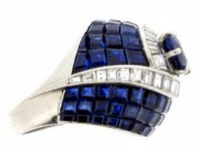14 DAY MONEY-BACK GUARANTEE - FREE WORLDWIDE DELIVERY
SAME-DAY LONDON DELIVERY

'Serti Mysterieux' or invisible setting as it is known in English has fascinated people for much of the last century. It is based on a very simple premise. You should only see gemstones, no metal should be visible in the setting.
In 1929, a relatively unknown Parisian jeweller named Jacques-Albert Algier developed and patented a method of holding a stone in place without pushing metal over it - no claws, no collets. He did this by carving a groove in the side of the gem and sliding the gem along rails of precious metal, setting gemstone next to gemstone and effectively masking the metal. It gave him what appeared to be an invisible setting.
In Spring 1933, Cartier picked up on this method of setting and used it sparingly, but with an already full catalogue of Art Deco pieces they did not pursue it further.
Enter Van Cleef & Arpels. This was the perfect firm for the 'serti mysterieux', with Alfred Van Cleef being an accomplished lapidary (stone cutter) himself and Julien Arpels a stone aficionado. Having founded VCA in 1906 they were keen to make a name for themselves. In December 1933, nine months after Cartier they filed a patent for a process they called 'serti mysterieux'. VCA were not the only ones to use invisible settings, but of the few houses who did, they alone are responsible for popularising it.
One of the many difficulties in this particular setting is cutting a precise groove on either side of a stone. The stones used were so small and the level of precision required so great that they would have used crude saw blades made of silk and coated in diamond powder. The amount of stones broken in this process was enormous. They needed approximately 50% more stones to account for wastage with this type of setting. Invisibly set pieces would also take months to complete, with the more complicated pieces requiring even longer than that.
Not only did a gemstone have to be grooved in perfectly straight lines, but they also had to be faceted precisely to fit next to each other with no gaps. This calibré cutting required the lapidary and the jeweller to work hand in hand to ensure that all the component parts fit perfectly.
Serti mysterieux was an immediate success. It remains to this day the finest example of the jeweller's capability for combining beauty with technical ability.
We are very fortunate to have been given the opportunity to purchase this rare vintage example of invisible setting. And, we hope that the lucky lady who gets to wear it will treasure it as much as we have.
Connect with us
Signs up for regular emails on our new acquisitions, news and features: